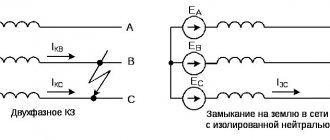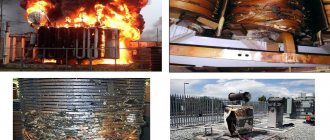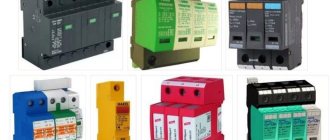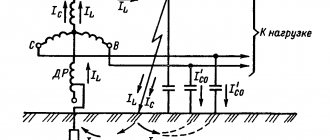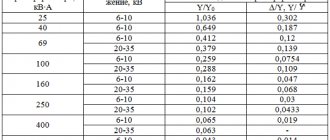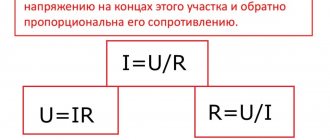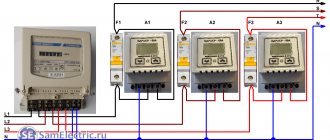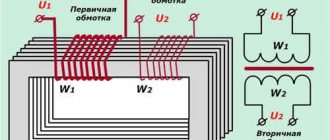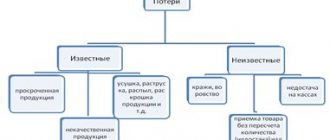Network overvoltage concept
Different sources provide different definitions of “overvoltage” in a network. Here is the definition of this concept given by Wikipedia:
The Nautical Dictionary defines overvoltage as an increase in voltage in power lines and electrical networks to such a level that it may damage the insulation.
According to GOST R 54130-2010, overvoltage is the excess of the highest operating voltage, which is set for a given type of electrical equipment.
The Russian Encyclopedia of Occupational Safety defines overvoltage as a significant voltage of a conductor relative to the ground, which can significantly exceed the phase voltage as a result of internal or atmospheric phenomena
Causes of overvoltage
Thunderstorm activity
This is the most dangerous of emergency situations, because lightning discharges are very powerful. A lightning discharge can enter directly into the electrical network, striking an overhead wire, or enter a lightning rod.
But even if a lightning strike occurs at some distance, the electrical network can be damaged as a result of electromagnetic influence and overvoltage.
With such impacts, the surge voltage can reach tens of thousands of volts in just micro-fractions of a second.
You need to know that even if a building is equipped with a lightning rod, this does not provide one hundred percent protection from lightning: a significant part of it will go into the ground, and the remaining energy will be randomly distributed throughout the building’s electrical network.
Switching load
When powerful units are turned on or off, sudden changes occur in the stationary mode of network operation.
Oscillations with frequencies of up to hundreds of kilohertz can occur in the circuits. Peak voltage surges will therefore also be significant.
The cause of a critical overvoltage in the network and failure of electrical equipment can be, for example, the shutdown of a powerful power transformer and the instant release of its accumulated energy in the form of magnetic saturation.
Characteristics of overvoltage in the electrical network
In general, overvoltage can be considered any significant increase in voltage in the network caused by various reasons. Voltage drops can have different amplitudes, durations and frequency.
The main characteristics of overvoltage include:
- peak voltage value
- overvoltage repetition rate
- time of the rise period of the overvoltage value
- area or length of overvoltage propagation in the network
- total number of surges over a period of time
- total time of the entire overvoltage cycle
Emergency breaks in networks
A frequent type of accident in networks is the so-called “zero break”, in other words, the break of the neutral conductor in a three-phase power network.
A phenomenon called “phase imbalance” occurs, since the voltage is redistributed depending on the phase load.
Such emergency situations most often occur on transformers that do not have appropriate compensating equipment.
Electrostatic factors of power supply overvoltage
There are materials that can accumulate and retain electrical charge. This property is greatly enhanced in dry air. Such electrostatic potentials are not felt until a discharge occurs.
A discharge occurs completely unexpectedly if you accidentally touch pipes or heating radiators, or metal parts of equipment connected to the electrical network.
You can accumulate an electrostatic potential of several thousand volts if you walk on carpeted floors in dielectric shoes.
When you touch the body of equipment connected to the network, for example, a computer case, a discharge lasting several nanoseconds will occur.
This discharge may be enough to damage some electronic parts of your computer.
Types of overvoltage in the electrical network
In general, according to the method of formation, internal (or switching) and external (lightning or atmospheric) overvoltages are distinguished
There are the following main types of overvoltage in the electrical network:
- lightning surges
- inductive overvoltages
- quasi-stationary overvoltages
- switching overvoltages
Methods for protecting the electrical network
First of all, electrical networks must initially be installed taking into account the requirements of GOST and must be equipped with all necessary surge protection devices.
It is impossible to completely protect electrical networks from surge voltages, but it is quite possible to reduce their values to a safe level.
Manufacturers of modern electrical equipment are familiar with these risks, so products are manufactured with a certain margin of critical sensitivity to peak overvoltage values.
But users of household equipment need to take their own protective measures:
- Install a lightning rod at your home;
- Install special surge protection equipment, the so-called SPD;
- Install a voltage relay and a residual current circuit breaker at the entrance to the apartment, on the power supply panel.
By protecting your home in this way, you will significantly reduce the risk of damage to your electrical network and electrical appliances in the event of emergency overvoltages in the network and accidental lightning strikes.
Quasi-stationary overvoltage in the network
Quasi-stationary overvoltages in the network can last from several seconds to several minutes. Such overvoltages are dangerous for equipment connected to the network.
Quasi-stationary overvoltages occur for the following reasons:
- the appearance of dangerous resonance in the electrical network
- in case of short circuits in the network
- during an emergency increase in the speed of the electric generator in the event of a sharp drop in the load value in the network
- when the ferroresonance effect appears in networks with powerful inductive coils or magnetic cores
What is network overvoltage and what is its danger?
This term means an increase in voltage in electrical networks or power lines above the established norm. It is limited to 5.0% and 10.0% (permissible and maximum permissible deviation, respectively). GOST 13109 91, which describes the standards that the quality of electricity must comply with, gives a more detailed definition of this effect. The regulatory document describes two options for the manifestation of high voltage :
- Pulse overvoltage. It manifests itself as a sharp increase in voltage amplitude, after which a decrease to the original or close to it level is observed (see A in Fig. 1). Pulse duration is less than 10.0 milliseconds.
- The effect of temporary overvoltage. In this case, an excess of more than 10.0% of the nominal value is observed for longer than 10.0 ms (see B in Fig. 1).
Overvoltages are dangerous because they can not only damage devices connected to the network, but also destroy the insulation of electrical equipment. In the latter case, a threat to human life is created and the risk of an emergency situation increases. Damage to the insulation of electrical installations quite often causes fires.
Fire caused by overvoltage
In this regard, when choosing insulation, you must be guided by the relevant standards; detailed information about this can be found on the pages of our website.
Network surge protection
The responsibility for protecting electrical networks from natural and man-made factors lies with the organizations servicing these networks. Equipment for lightning protection and protection against voltage surges in high-voltage networks is installed on transmission line supports and masts, and at electrical substations of all levels. Network protection equipment is also installed at substations of factories and factories, power substations for powering electric transport networks.
To protect the electrical equipment of the house and household electrical appliances in private houses and apartments, local devices can be installed to protect against voltage surges and surges.
manufactures a line of surge and surge protection devices. More information about these devices can be found in the “Power Surge Protection” section.
All voltage protection devices comply with the requirements of Russian and international standards.
Albatross surge and surge protection devices will reliably protect your network, electrical equipment and household appliances from the harmful effects of power surges and surges.
Main reasons
Since external factors of influence have already been considered, let’s immediately move on to the internal reasons that cause an increase in voltage, starting in order. Switching factors:
- Abrupt load shedding when protective devices are triggered, for example, air circuit breakers, creates strong interference, especially during an emergency shutdown of power lines.
- Switching of capacitor units.
- Turning off powerful electrical machines and power transformers (causes the impact of inductive currents on the line).
- Reswitching of lines.
An example of typical switching voltage deviation is marked in blue in the graph below.
Typical switching overvoltage
Quasi-stationary deviations can be caused by the following factors:
- Regime , these include:
- asymmetrical short circuit to earth in a network with an isolated neutral;
- arc faults in lines with voltage 6.0-35.0 kV (arc overvoltage);
- acceleration of the generating set due to sudden load shedding;
- incorrect phasing of transformer installations;
- other unfavorable combinations of EMF in the electrical network.
- Resonant overvoltages . They arise when the frequencies of the forced EMF and a separate section of the network are close to coincidence. If this happens, the "capacitive effect" will result in overvoltage.
In the case when the line operates in open-phase mode and a transformer with a grounded neutral is connected to it, there is a high probability of the formation of a resonant circuit. The interaction will occur between the inductance of the transformer installation and the interphase capacitance and will also cause a high overvoltage factor.
- Ferroresonance overvoltage . This type of deviation can be observed during the formation of a resonant oscillatory circuit that meets the following conditions:
- frequency is close to 50.0 Hz;
- lower and higher harmonics occur;
- the inductive component has a saturated magnetic circuit.
In the open-phase operating mode of the system, the effect of ferroresonance is possible in circuits where there is inductance formed by transformers connected in series.

